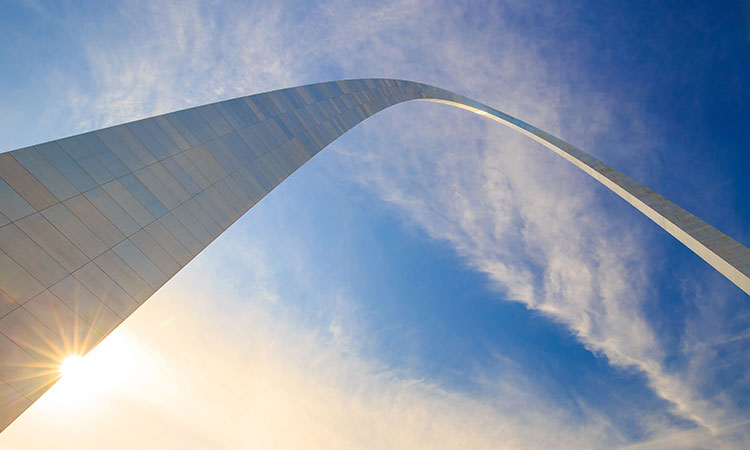
Once known as a “miracle fiber” for properties useful in construction, asbestos is now far from remarkable. Today, we know that the mineral causes fatal health complications, including asbestosis and the rare cancer mesothelioma. Discovery of these
risks led to federal action, first beginning in the 1970s, to control the use of asbestos in certain products. By this time, however, many of the country’s buildings had
already been built with this silent killer, contributing to 10,000 deaths annually in America. Asbestos-containing buildings even included renowned United States landmarks. Here, we take a look at a few that were once not only tourist attractions but
also known health hazards.
1.) Gateway Arch, Missouri The Gateway Arch, currently the most modern and expensive landmark in St. Louis, is a 630-ft.-tall monument featuring the Museum of Westward Expansion underneath. In 2015, workers began renovation of the museum.
Soon after, they halted operations after finding asbestos insulation
around old piping. Park officials immediately evacuated the site – but not before exposing about 100 employees and contractors to airborne asbestos. A month prior, workers had unknowingly cut into the very same pipe, leaving the whole site contaminated
for weeks. Renovation work restarted a mere month later, but the closure cost $350,000 in lost revenue – as well as workers’ health.
2.) Kennedy Space Center, Florida NASA’s John F. Kennedy Space Center (KSC), located in Titusville, is known to have involved asbestos in several construction projects. In fact, a report found 90 percent of the buildings contained asbestos “in one form or another,” though researchers were unable to find every exact location. Space center officials disputed this audit, but were forced to close 22 mechanical rooms.
In 2010, NASA also had to demolish its first Mission Control Center – a building erected in the mid-1950s – due to asbestos concerns. The staggering cost of the repair work
to the building proved to be too much, and its consoles and equipment were shipped to a nearby museum.
3.) World Trade Center, New York As if the inconceivable tragedy of 9/11 wasn’t bad enough, asbestos was found both in the rubble of the twin towers and in the toxic dust that spread throughout New York City in the aftermath of the attacks.
According to the New York Committee for Occupational Safety and Health (NYCOSH), asbestos was a major material used in World Trade Center construction. So, when the buildings came down, thousands of people in Lower Manhattan were exposed to an “optically dense” dust containing an array of carcinogenic substances including asbestos. The force of this dust, NYCOSH says, may have even penetrated surrounding buildings and dispersed over miles of Manhattan and Brooklyn neighborhoods.
4.) Statue of Liberty, New York Built in France in 1875, the Statue of Liberty now resides on Liberty Island in New York City. The sculpture’s design has become one of the world’s most iconic symbols and an important memorial of independence
for the United States. But at one time, it was also famous for containing asbestos. Lady Liberty’s designers, Frédéric Auguste Bartholdi and Gustave Eiffel, used the mineral to insulate the copper skin of the construction and prevent galvanic erosion.
5.) The Pentagon, Washington, D.C. The U.S. Navy is now considered one of the largest causes of asbestos exposure and subsequent health concerns – but it’s not
the only military branch associated with these issues. The Pentagon, headquarters of the United States Department of Defense, also contained asbestosin ceiling plaster, heating and ventilating ducts, pipes and floor coverings. Asbestos removal finally began with the building’s renovation in the 1990s and was completed in 2011 – ridding the Pentagon of 70,000 cubic yards of asbestos. Asbestos has since been removed from the rest of these sites, too. However, before its use was outlawed several decades ago, any exposure to the mineral may
have put hundreds of thousands of workers and visitors at risk. If you are concerned that you or a loved one may have been exposed to asbestos, learn what to do next and how to stay safe in
the future.
Sources
- www.simmonsfirm.com/mesothelioma/asbestos-exposure/
- www.simmonsfirm.com/mesothelioma/cancer/
- https://www.epa.gov/asbestos/epa-actions-protect-public-exposure-asbestos
- http://www.collectspace.com/news/news-050410a.html
- https://www.orlandosentinel.com/news/os-xpm-1992-07-31-9207310369-story.html
- http://nycosh.org/wp-content/uploads/2014/09/NYCOSH-Protecting-Worker-1-17-14-FINAL.pdf
- http://failuremag.com/article/10-things-you-didnt-know-about-the-statue-of-liberty
- www.simmonsfirm.com/mesothelioma/veterans/navy/
- https://www.defense.gov/
- https://www.washingtonpost.com/politics/after-17-years-pentagon-renovation-is-complete/2011/06/03/AGBpp3eH_story.html?utm_term=.3f5cc610a157




